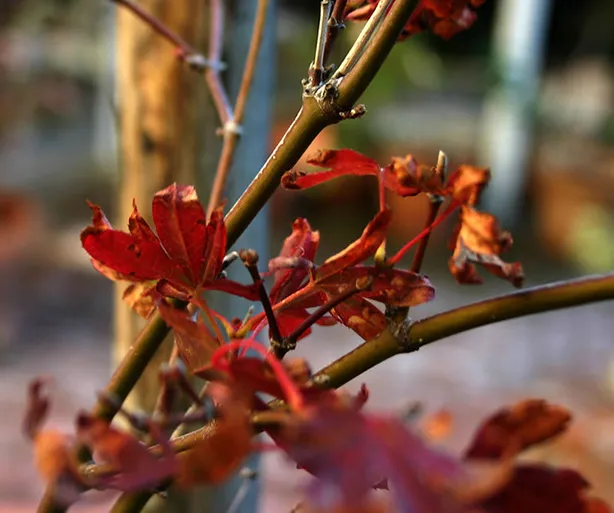Acer palmatum, also known as Japanese maple, is a beautiful and popular plant that can add an exotic touch to any garden. However, it can be distressing to find that your Acer palmatum is not thriving, and may even be dying. In this article, we’ll explore some common reasons why your Acer palmatum may be struggling and provide some tips on how to revive it.

Signs of a Dying Acer Palmatum Plant
Before we delve into the causes of a dying Acer palmatum plant, let’s first look at some of the signs that your plant may not be doing well. Some common symptoms of a struggling Acer palmatum include:
- Discolored or wilted leaves
- Leaf drop
- Stunted growth
- Dead branches or twigs
- Reduced or no flowering
If you notice any of these symptoms in your Acer palmatum plant, it’s time to investigate the cause and take action.
Causes of a Dying Acer Palmatum Plant
There are several factors that can contribute to the decline of an Acer palmatum plant. Let’s take a look at some of the most common causes.
1. Overwatering or Underwatering
Both overwatering and underwatering can cause stress to an Acer palmatum plant. Overwatering can lead to root rot, while underwatering can cause the plant to dry out and become dehydrated. To determine if your plant is getting the right amount of water, check the soil regularly. It should be moist but not waterlogged. If the soil is dry, it’s time to water your plant. If the soil is wet, hold off on watering until the top inch of soil feels dry.
2. Poor Soil Conditions
Acer palmatum plants prefer well-draining soil that is rich in organic matter. If the soil is too heavy or dense, it can retain too much water and suffocate the roots. On the other hand, if the soil is too sandy or lacks nutrients, the plant may not receive the proper nourishment it needs to thrive. To improve soil conditions, add organic matter such as compost, manure, or leaf mold to the soil.
3. Pests and Diseases
Acer palmatum plants can be susceptible to pests and diseases, including spider mites, aphids, fungal leaf spot, and verticillium wilt. These issues can cause leaf drop, leaf discoloration, and even death. To prevent pests and diseases, keep the plant healthy by providing proper care, including regular watering and fertilizing, pruning dead or diseased branches, and removing fallen leaves.
4. Environmental Factors
Environmental factors, such as extreme temperatures, wind, and exposure to direct sunlight, can also contribute to a dying Acer palmatum plant. The plant prefers partial shade or filtered sunlight, and exposure to direct sunlight for extended periods can scorch the leaves. In addition, extreme heat or cold can cause stress and lead to leaf drop.
How to Revive a Dying Acer Palmatum Plant
If you’ve identified the cause of your Acer palmatum plant’s decline, there are steps you can take to revive it. Here are some tips:
1. Adjust Watering Habits
If the soil is too wet, cut back on watering and allow the soil to dry out before watering again. If the soil is too dry, increase watering frequency and ensure that the plant is receiving enough moisture.
2. Improve Soil Conditions
To improve soil conditions, add organic matter such as compost or manure to the soil. This will improve drainage and provide the plant with the necessary nutrients.
3. Address Pests and Diseases
If pests or diseases are causing issues, use an appropriate insecticide or fungicide to treat the plant. Be sure to follow the instructions carefully to avoid damaging the plant further.
4. Provide Proper Environmental Conditions
Ensure that the plant is not exposed to direct sunlight for extended periods and that it is receiving the right amount of light. Consider moving the plant to a more suitable location if necessary. In addition, protect the plant from extreme temperatures and winds.
FAQ
How often should I water my Acer palmatum plant?
It’s important to keep the soil moist but not waterlogged. Check the soil regularly, and water when the top inch of soil feels dry. This can range from once a week to once every few days, depending on factors such as temperature and humidity.
Can I prune a dying Acer palmatum plant?
Pruning can help to remove dead or diseased branches and promote new growth, but be cautious not to prune too much or too aggressively, as this can stress the plant further. Prune in the late winter or early spring before new growth appears.
What type of soil is best for Acer palmatum plants?
Acer palmatum plants prefer well-draining soil that is rich in organic matter. Consider adding compost, manure, or leaf mold to the soil to improve its texture and nutrient content.
How can I prevent pests and diseases from affecting my Acer palmatum plant?
Keeping the plant healthy is key to preventing pests and diseases. Provide proper care, including regular watering and fertilizing, pruning dead or diseased branches, and removing fallen leaves. Consider using an appropriate insecticide or fungicide if necessary, but be sure to follow instructions carefully to avoid damaging the plant.
Conclusion
A dying Acer palmatum plant can be distressing, but with some investigation and proper care, it is possible to revive it. Remember to check the soil regularly, provide proper environmental conditions, and address any pests or diseases promptly. With patience and persistence, your Acer palmatum plant can once again thrive and add beauty to your garden.
